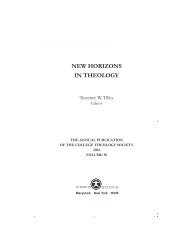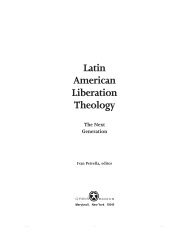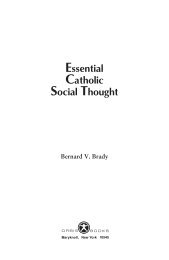CONCEPTS OF MISSION - Orbis Books
CONCEPTS OF MISSION - Orbis Books
CONCEPTS OF MISSION - Orbis Books
You also want an ePaper? Increase the reach of your titles
YUMPU automatically turns print PDFs into web optimized ePapers that Google loves.
Mission in Contemporary Missiology 19<br />
time Christianity was spreading to most parts of the global South, beginning<br />
with the fifteenth-century missionary expansion, the Protestant Reformation<br />
had just begun. As a result of the latter, the Council of Trent (1545-1563)<br />
was convoked. This council, intending to safeguard the unity of the church<br />
in the face of the Protestant Reformation, initiated a Counter-Reformation.<br />
It called for the uniformity of the entire church, including the young<br />
churches. Therefore, missionaries had no choice but to join in the effort<br />
toward the unity of the church and of the Christian faith (Oborji 1998, 72).<br />
Again, in the nineteenth century, in the midst of a divided church in the<br />
West, there arose the modernist movement. The unity of the Christian faith<br />
was once more threatened. And in an effort to safeguard the unity of the<br />
faith, Vatican Council I (1870) presented a theology of revelation that left little<br />
room for recognition of elements of revelation outside the Catholic<br />
Church (Dulles 1983, 51-52). In all this, one needs to compare the mentality<br />
or attitude of the church with that of the rest of the world at the time. Other<br />
world cultures or religions were as well not engaged in dialogue. Furthermore,<br />
the underdeveloped state of social sciences, especially cultural anthropology<br />
at the time, did not help the matter either. Cultural anthropology at<br />
the time judged most peoples outside the North Atlantic world as peoples<br />
without culture and civilization. Africans, more than any other race of the<br />
human family, seemed to have suffered most from this kind of stereotype.<br />
Invariably, this underdeveloped nature of cultural anthropology influenced<br />
missionary theories and practice during that time. To be noted as well<br />
is the fact that up to the beginning of twentieth century, there was no welldeveloped<br />
theology of mission in both Catholic and Protestant circles. And<br />
when it came to be developed, it started when the theology of adaptation<br />
was in vogue: the salvation of souls and the implanting of the church<br />
throughout the world as the universal means of salvation intended by God<br />
for humankind. The two perspectives, salvation of souls and implanting of<br />
the church, are two aspects of the church’s missionary endeavor. The latter<br />
persisted until Vatican Council II. The former has been broadened by the<br />
term evangelization, especially with the modern emphasis on integral evangelization.<br />
Furthermore, several documents of Vatican II speak positively of<br />
the necessity of adaptation in describing the same reality that the word<br />
“inculturation” today addresses (SC 37-40).<br />
The theological foundation of inculturation is the incarnation. The basic<br />
argument is that just as Jesus Christ, the Word of God, became incarnate in<br />
a human culture, in the Jewish milieu, the gospel of Jesus Christ should be<br />
allowed to be inculturated (or incarnated) in the local culture and context<br />
(Matt 5:17; Acts 10:34). In this case, incarnation as the theological model of<br />
inculturation could be explained in two senses. In the first sense, it means the<br />
process of mutual penetration of the gospel and culture so that Jesus Christ<br />
may be present “today” in every culture. In this particular sense, the event<br />
of the incarnation continues in time; it happens each time the gospel is made
















